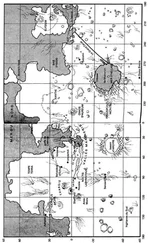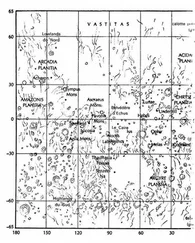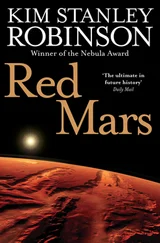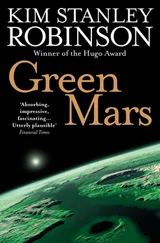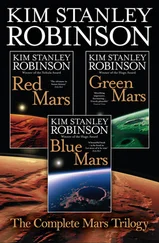Many agreed with that, including a lot of the Terran scientific community, which influenced the UNOMA committee charged with overseeing the colony. But every time Sax heard the argument he blinked rapidly. “There’s no sign of life on the surface,” he would say mildly. “If it does exist it has to be underground, near volcanic vents I suppose. But even if there is life down there, we could search for ten thousand years and never find it, nor eliminate the possibility it isn’t down there somewhere else, somewhere we haven’t looked. So waiting until we know for sure that there is no life—” which was a fairly common position among moderates—”effectively means waiting forever. For a remote possibility which terraforming wouldn’t immediately endanger anyway.”
“Of course it would,” Ann would retort. “Maybe not immediately, but eventually the permafrost would melt, there would be movement through the hydrosphere, and contamination of all of it by warmer water and Terran lifeforms, bacteria, viruses, algae. It might take a while, but it would surely happen. And we can’t risk that.”
Sax would shrug. “First, it’s postulated life, very low probability. Second, it wouldn’t be endangered for centuries. We could presumably locate it and protect it in that time.”
“But we may not be able to find it.”
“So we stop for low-probability life we can never actually find?”
Ann shrugged. “We have to, unless you want to argue that it’s okay to destroy life on other planets, as long as we can’t find it. And don’t forget, indigenous life on Mars would be the biggest story of all time. It would have implications for the galactic frequency of life that are impossible to exaggerate. Looking for life is one of the main reasons we’re here!”
“Well,” Sax would say, “in the meantime, life that we are quite sure exists is being exposed to an extraordinarily high amount of radiation. If we don’t do something to lessen it, we may not be able to stay here. We need a thicker atmosphere to cut down on radiation.”
This was not a reply to Ann’s point but the substitution of another one, and it was an argument that was very influential. Millions on Earth wanted to come to Mars, to the “new frontier,” where life was an adventure again; waiting lists for emigration both real and fake were massively oversubscribed. But no one wanted to live in a bath of mutagenic radiation, and the practical desire to make the planet safe for humans was stronger in most people than the desire to preserve the lifeless landscape already there, or to protect a postulated indigenous life that many scientists assured them did not exist.
So it did seem, even among those urging caution, that terraforming was going to happen. A subcommittee of UNOMA had been convened to study the issue, and on Earth it was now in the nature of a given, an unavoidable part of progress, a natural part of the order of things. A manifest destiny.
On Mars, however, the issue was both more open and more pressing, not so much a matter of philosophy as of daily life, of frigid poisonous air and the radiation being taken; and among those in favor of terraforming, a significant group was clustering around Sax— a group that not only wanted to do it, but to do it as fast as possible. What this meant in practice no one was sure; estimates of the time it would take to get to a “human-viable surface” ranged from a century to 10,000 years, with extreme opinions on either end, from thirty years (Phyllis) to 100,000 years (Iwao). Phyllis would say, “God gave us this planet to make in our image, to create a new Eden.” Simon would say, “If the permafrost melts we’d be living on a collapsing landscape, and a lot of us would be killed.” Arguments wandered over a wide range of issues: salt levels, peroxide levels, radiation levels, the look of the land, possibly lethal mutations of genetically engineered microorganisms, and so on.
“We can try to model it,” Sax said, “but the truth is we’ll never be able to model it adequately. It’s too big, and there are too many factors, many of them unknown. But what we will learn from it will be useful in controlling Earth’s climate, in avoiding global warming or a future ice age. It’s an experiment, a big one, and it will always be an ongoing experiment, with nothing guaranteed or known for sure. But that’s what science is.”
People would nod at this.
Arkady as always was thinking of the political point of view. “We can never be self-sufficient unless we do terraforming,” he pointed out. “We need to terraform in order to make the planet ours, so that we will have the material basis for independence.”
People would roll their eyes at this. But it meant that Sax and Arkady were allies of a sort, and that was a powerful combination. And so the arguments would go around, again and again and again, endlessly.
And now Underhill was nearly complete, a functioning and in most ways a self-sufficient village. Now it was possible to act further; now they had to decide what to do next. And most of them wanted to terraform. Any number of projects had been proposed to begin the process, with advocates for each, usually those who would be responsible for doing it. This was an important part of terraforming’s attraction; every discipline could contribute to the enterprise in one way or another, so it had broad-based support. The alchemists talked about physical and mechanical means to add heat to the system; the climatologists debated influencing the weather; the biosphere team talked about ecological systems theories to be tested. The bioengineers were already working on new microorganisms: shifting, clipping and recombining genes from algae, methanogens, cyanobacteria, and lichens, trying to come up with organisms that would survive on the present Martian surface, or under it. One day they invited Arkady to take a look at what they were doing, and Nadia went along with him.
They had some of their prototype GEMs in Mars jars, the largest of which was one of the old habitats in the trailer park. They had opened it up, shoveled regolith onto the floor, and sealed it again. They worked inside it by teleoperation, and viewed the results from the next trailer over, where instrument gauges took readings, and video screens showed what the various dishes were producing. Arkady looked at every screen closely, but there wasn’t that much to see: their old quarters, covered with plastic cubicles filled with red dirt, robot arms extending from their bases against the walls. There were visible growths on part of the soil, a bluish furze.
“That’s our champion so far,” Vlad said. “But still only slightly areophylic.” They were selecting for a number of extreme characteristics, including resistance to cold and dehydration and UV radiation, tolerance for salts, little need for oxygen, a habitat of rock or soil. No single Terran organism had all these traits, and those that had them individually were usually very slow growers, but the engineers had started what Vlad called a mix-and-match program, and recently they had come up with a variant of the cyanophyte that was sometimes called bluegreen algae. “It is not precisely thriving, but it does not die so fast, let us put it that way.” They had named it areophyte primares , its common name becoming Underhill algae. They wanted to make a field trial with it, and had prepared a proposal to send down to UNOMA.
Arkady left the trailer park excited by the visit, Nadia could see, and that night he said to the dinner group, “We should make the decision on our own, and if we decide in favor, act.”
Maya and Frank were outraged by this, and clearly most of the rest were uncomfortable as well. Maya insisted on a change of subject, and awkwardly the dinner conversation shifted. The next morning Maya and Frank came to Nadia, to talk about Arkady. The two leaders had already tried to reason with him, late the night before. “He laughs in our face!” Maya exclaimed. “It’s useless to try to reason with him!”
Читать дальше
Конец ознакомительного отрывка
Купить книгу





